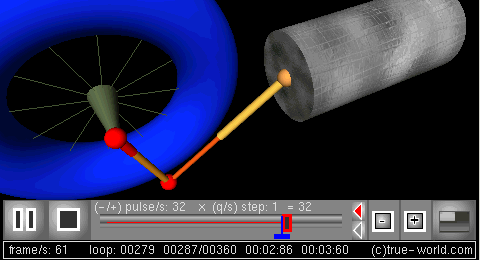Facts for Kids
Dynamics is a part of classical mechanics that studies how objects move and the forces that affect that motion.
Overview
Types Of Forces
Free Body Diagrams
Rotational Dynamics
Dynamics In Engineering
Kinematics Vs Dynamics
Newton's Laws Of Motion
Fundamentals Of Dynamics
Energy And Work In Dynamics
Applications Of Dynamics In Real Life

Inside this Article
Classical Mechanics
Rotational Motion
Isaac Newton
Kinematics
Skyscraper
Universe
Gravity
Energy
Force
Day
Did you know?
🌍 Dynamics is all about understanding how things move!
🚀 Forces can push or pull things, affecting how they move.
📏 Gravity is a famous force that pulls everything towards the Earth.
🦸♂️ Sir Isaac Newton created three laws that explain how objects move.
⛵ For every action, there's an equal and opposite reaction, according to Newton's third law.
💪 Friction is a force that slows things down, like rubbing your hands together.
🌌 In space, there’s almost no friction, allowing rockets to move fast!
🎢 Amusement park rides use dynamics to thrill us with their movement.
🤝 Kinematics looks at how things move, while dynamics explores why they move.
🖊️ Free Body Diagrams help us understand all the forces on an object.
Introduction
Imagine throwing a ball or riding a bicycle; that's dynamics in action! It’s a part of classical mechanics, which studies how objects like cars, rockets, and planets move. In dynamics, we look at forces (which can push or pull things) and how they affect an object's motion. For example, when you push a toy car, it moves. The study of dynamics helps us track speeds, directions, and changes in motion. 🚀
So, let’s explore the exciting world of dynamics together!
Types Of Forces
Friction is another force that slows things down, like when you rub your hands together. There’s also magnetic force, found in magnets that can attract or repel things! 💪
Did you know that in space, there's almost no friction? That allows rockets to move really fast! Each type of force helps us understand how objects move differently, making dynamics super interesting! 🌌
Free Body Diagrams
When scientists and engineers want to understand all the forces acting on an object, they draw these diagrams. Imagine a box being pushed; they draw it with arrows showing pushes and pulls. Each arrow’s size tells us how strong the force is! 📐
FBDs help us see the big picture and know which forces need to be balanced for the object to move or stay still. They make understanding dynamics much easier! 🖊
️
Rotational Dynamics
️ When you twirl a ball on a string, that's rotational motion! Just like how a skateboard can rotate when you do tricks! 🛹
In rotational dynamics, we explore how forces affect an object's rotation, like how harder spins make it go faster. Gravity plays a role too; think of merry-go-rounds at a playground. Kids hold on tight as they spin around! That’s rotational dynamics in real life! 🤩
It’s fascinating how forces make things turn!
Dynamics In Engineering
️ They use it to design everything from bridges to airplanes! By studying forces, they can make sure buildings can withstand strong winds or earthquakes. Engineers also use dynamics in cars to ensure they are safe and fast. 🚥
Understanding dynamics helps them create better machines and tools. So, whether it's a simple toy or a grand skyscraper, dynamics plays a major role in making sure they work correctly! 🎉
Kinematics Vs. Dynamics
Kinematics focuses on how objects move without worrying about why they move. It asks questions like “How fast is the car going?” or “What direction is the ball moving?” Dynamics, on the other hand, looks harder at the forces that make those movements happen! ⚙
️ So, while kinematics studies motion, dynamics dives into the reasons behind that motion. Both are essential for understanding the movement of objects!
Newton's Laws Of Motion
♂️ He created three laws to explain how objects move. The first law says that an object will stay still or keep moving in a straight line unless a force acts on it. The second law tells us that the more force you use, the faster an object will move. Lastly, the third law says that for every action, there's an equal and opposite reaction! So, when you jump off a small boat, you push the boat backward while you move forward! ⛵
Fundamentals Of Dynamics
Sir Isaac Newton, a famous scientist, helped us understand motion and forces more than 300 years ago. He discovered that everything in the universe is always moving or at rest unless a force makes it change! 🌌
Energy And Work In Dynamics
When we talk about work, we mean pushing or pulling something over a distance. For example, if you push a shopping cart, you’re doing work! Energy is what makes things happen. 🏃
When you run or ride your bike, you’re using energy. There are different types of energy, like kinetic (movement energy) and potential (stored energy, like in a stretched rubber band). Together, energy and work help us understand how objects move in dynamics! 🌈
Applications Of Dynamics In Real Life
When we drive cars, engineers use dynamics to design them to move safely and fast. Sports, like soccer, rely on dynamics to help players kick the ball accurately. Even in amusement parks, rides use principles of dynamics to thrill us, like roller coasters speeding through twists and turns! 🎢
Learn about dynamics, and you’ll understand how everything around you moves, from animals to airplanes! ✈
️ Every day is a dynamics adventure!

